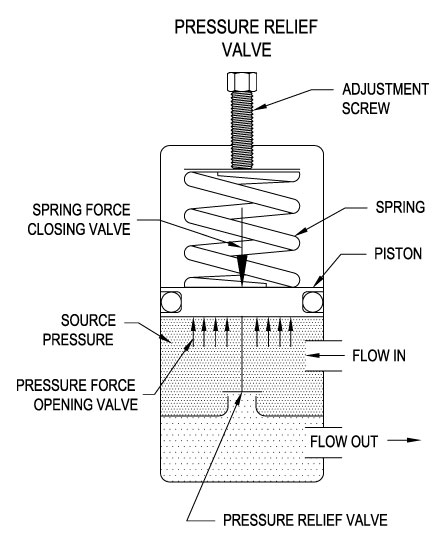Pressure Relief Valve Basics
A pressure relief valve, at times called a relief valve, is one that is used to control or put a limit on the pressure within any given system to prevent it from building up and causing damage to equipment or causing more serious hazards. The valves allow media to flow from an auxiliary passage and out of the system once a certain pressure is reached, whether it is a maximum or minimum level. The valve will then open to release the pressure in order to protect the system. Once the pressure returns to normal levels, the valve is then closed.
Types of Pressure Relief Valves
Pressure relief valves can be classified into two categories:
- Pilot operated pressure relief valves – These valves are operated by hand and are opened often through the use of a wheel, crank, or similar device. The operator will often open the valve when they read a gauge or other readout in the system signifying the pressure is at unacceptable levels. They open the valve to relief the pressure then shut it by hand.
- Direct operated pressure relief valves – These valves are programmed to open when pressure reaches an unacceptable level usually though a spring mechanism. They can be controlled by a remote, computer program, control panel, and many other means. The valves are also often programmed to shut automatically when the pressure is relieved.
Other types of pressure relief valves include:
- Low pressure safety valve – These valves use the static pressure of a gas to relieve the system when the relieving pressure is low and close to atmospheric pressure.
- Pressure safety valve – The main difference between these and a pressure relief valve is they are operated with a manual lever to activate the valve in case of emergencies.
- Safety valve – They operate on a similar principle as a standard pressure relief valve, use full lift or snap to operate, and are commonly used in the gas industry.
- Vacuum pressure safety valve – This is a direct relief valve that also uses the static pressure of a gas when the pressure is small, negative, and also close to atmospheric pressure.
Pressure Relief Valve Applications
Pressure relief valves are used in a wide range of specifications where pressure levels are critical for smooth operations such as oil and gas, petrochemical, and power generation using steam, air, gas or liquid. They are also used in multi-phase applications in refining and chemical processing systems.
Pro’s and Con’s of Pressure Relief Valves
The main advantage to a pressure relief valve is to avoid improper functioning of the system when the pressure is off. In fact, pressure relief valves were invented as the result of boilers exploding when not properly monitored. Pressure relief valves are a must when maintaining a system in order to avoid dangerous situations, as well as for maintaining a constant flow of media, and extending the life of equipment. This type of valve is unnecessary in systems where high or low pressure is not a factor.
Advances in Pressure Relief Valves
Low Profile Pressure Relief Valve – Midland Manufacturing has designed a new pressure relief valve to help reduce the likelihood of valve shear-off during a rail tank-car rollover. It was built in response to customer feedback and demand for a valve that can handle the transport of ethylene oxide, a hazardous substance.
Griffco Unibody Back Pressure Valves – This latest innovation ensures leak-free connections and operations with the flexibility of changing connection types. The valves also provide ease of maintenance and help eliminate additional system components, which saves both time and money.
American Water Works Association Conference – Learn more about the latest in pressure relief valves and other similar technologies at one of the AWWA’s many conferences.
For More on Pressure Relief Valves
Water Tank’s Pressure-Relief Valve is Key Safety Component – Read an expert’s answer to a reader’s question on pressure relief valves used in water tanks in The Daily Herald.
Use of Rupture Discs in Combination With Relief Valves – Download this white paper from Fike to read all about how these two components work together to be a first line of defense in many types of scenarios.
A Management Study of Pressure Relief Valves – Authors Chi-Hui Chien, Chun-Hung Chen, and Yih-Shen Lin study the roles pressure relief valves play in protecting a system from pressure including how the valves can deteriorate in the wrong system.
Pressure Relief Valve Case Study – Process Engineering Associates provides a full range of services relative to the sizing, verification, and modeling of pressure safety relief valves. You can see exactly how they do it by reading this complimentary case study on “Unsteady State Relief Valve Evaluation External Pool Fire Scenario.”




